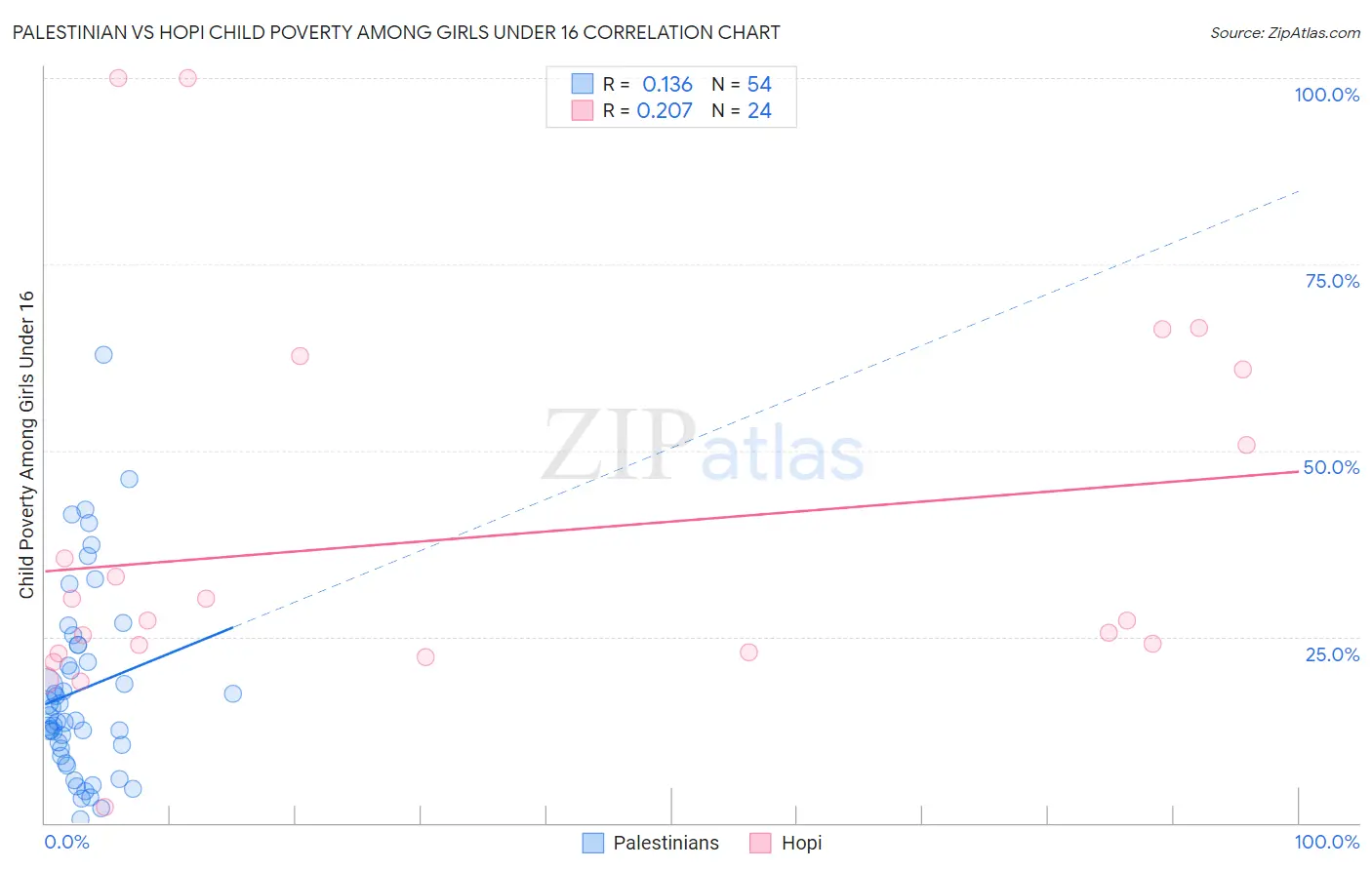Palestinian vs Hopi Child Poverty Among Girls Under 16
COMPARE
Palestinian
Hopi
Child Poverty Among Girls Under 16
Child Poverty Among Girls Under 16 Comparison
Palestinians
Hopi
15.1%
CHILD POVERTY AMONG GIRLS UNDER 16
94.5/ 100
METRIC RATING
111th/ 347
METRIC RANK
27.9%
CHILD POVERTY AMONG GIRLS UNDER 16
0.0/ 100
METRIC RATING
341st/ 347
METRIC RANK
Palestinian vs Hopi Child Poverty Among Girls Under 16 Correlation Chart
The statistical analysis conducted on geographies consisting of 214,720,256 people shows a poor positive correlation between the proportion of Palestinians and poverty level among girls under the age of 16 in the United States with a correlation coefficient (R) of 0.136 and weighted average of 15.1%. Similarly, the statistical analysis conducted on geographies consisting of 74,572,915 people shows a weak positive correlation between the proportion of Hopi and poverty level among girls under the age of 16 in the United States with a correlation coefficient (R) of 0.207 and weighted average of 27.9%, a difference of 84.2%.

Child Poverty Among Girls Under 16 Correlation Summary
| Measurement | Palestinian | Hopi |
| Minimum | 0.56% | 2.1% |
| Maximum | 62.9% | 100.0% |
| Range | 62.3% | 97.9% |
| Mean | 17.9% | 38.3% |
| Median | 14.1% | 27.2% |
| Interquartile 25% (IQ1) | 10.1% | 22.8% |
| Interquartile 75% (IQ3) | 23.9% | 55.8% |
| Interquartile Range (IQR) | 13.8% | 33.0% |
| Standard Deviation (Sample) | 12.8% | 25.3% |
| Standard Deviation (Population) | 12.6% | 24.7% |
Similar Demographics by Child Poverty Among Girls Under 16
Demographics Similar to Palestinians by Child Poverty Among Girls Under 16
In terms of child poverty among girls under 16, the demographic groups most similar to Palestinians are Immigrants from Croatia (15.1%, a difference of 0.040%), Immigrants from Kazakhstan (15.1%, a difference of 0.14%), Serbian (15.1%, a difference of 0.16%), Dutch (15.1%, a difference of 0.16%), and Immigrants from Brazil (15.1%, a difference of 0.25%).
| Demographics | Rating | Rank | Child Poverty Among Girls Under 16 |
| Romanians | 95.3 /100 | #104 | Exceptional 15.0% |
| Immigrants | England | 95.1 /100 | #105 | Exceptional 15.1% |
| Chileans | 95.1 /100 | #106 | Exceptional 15.1% |
| Immigrants | Ukraine | 95.0 /100 | #107 | Exceptional 15.1% |
| Immigrants | Brazil | 94.9 /100 | #108 | Exceptional 15.1% |
| Serbians | 94.8 /100 | #109 | Exceptional 15.1% |
| Immigrants | Croatia | 94.6 /100 | #110 | Exceptional 15.1% |
| Palestinians | 94.5 /100 | #111 | Exceptional 15.1% |
| Immigrants | Kazakhstan | 94.3 /100 | #112 | Exceptional 15.1% |
| Dutch | 94.3 /100 | #113 | Exceptional 15.1% |
| Sri Lankans | 94.0 /100 | #114 | Exceptional 15.2% |
| Belgians | 93.9 /100 | #115 | Exceptional 15.2% |
| Immigrants | Denmark | 93.3 /100 | #116 | Exceptional 15.2% |
| Immigrants | North Macedonia | 93.1 /100 | #117 | Exceptional 15.2% |
| Immigrants | Southern Europe | 92.7 /100 | #118 | Exceptional 15.3% |
Demographics Similar to Hopi by Child Poverty Among Girls Under 16
In terms of child poverty among girls under 16, the demographic groups most similar to Hopi are Pima (28.2%, a difference of 1.3%), Yuman (27.1%, a difference of 2.9%), Crow (26.4%, a difference of 5.7%), Immigrants from Yemen (29.5%, a difference of 5.9%), and Cheyenne (26.3%, a difference of 6.0%).
| Demographics | Rating | Rank | Child Poverty Among Girls Under 16 |
| Blacks/African Americans | 0.0 /100 | #333 | Tragic 24.7% |
| Menominee | 0.0 /100 | #334 | Tragic 25.0% |
| Pueblo | 0.0 /100 | #335 | Tragic 25.2% |
| Sioux | 0.0 /100 | #336 | Tragic 25.6% |
| Yup'ik | 0.0 /100 | #337 | Tragic 25.8% |
| Cheyenne | 0.0 /100 | #338 | Tragic 26.3% |
| Crow | 0.0 /100 | #339 | Tragic 26.4% |
| Yuman | 0.0 /100 | #340 | Tragic 27.1% |
| Hopi | 0.0 /100 | #341 | Tragic 27.9% |
| Pima | 0.0 /100 | #342 | Tragic 28.2% |
| Immigrants | Yemen | 0.0 /100 | #343 | Tragic 29.5% |
| Navajo | 0.0 /100 | #344 | Tragic 30.5% |
| Lumbee | 0.0 /100 | #345 | Tragic 30.7% |
| Tohono O'odham | 0.0 /100 | #346 | Tragic 31.6% |
| Puerto Ricans | 0.0 /100 | #347 | Tragic 32.7% |